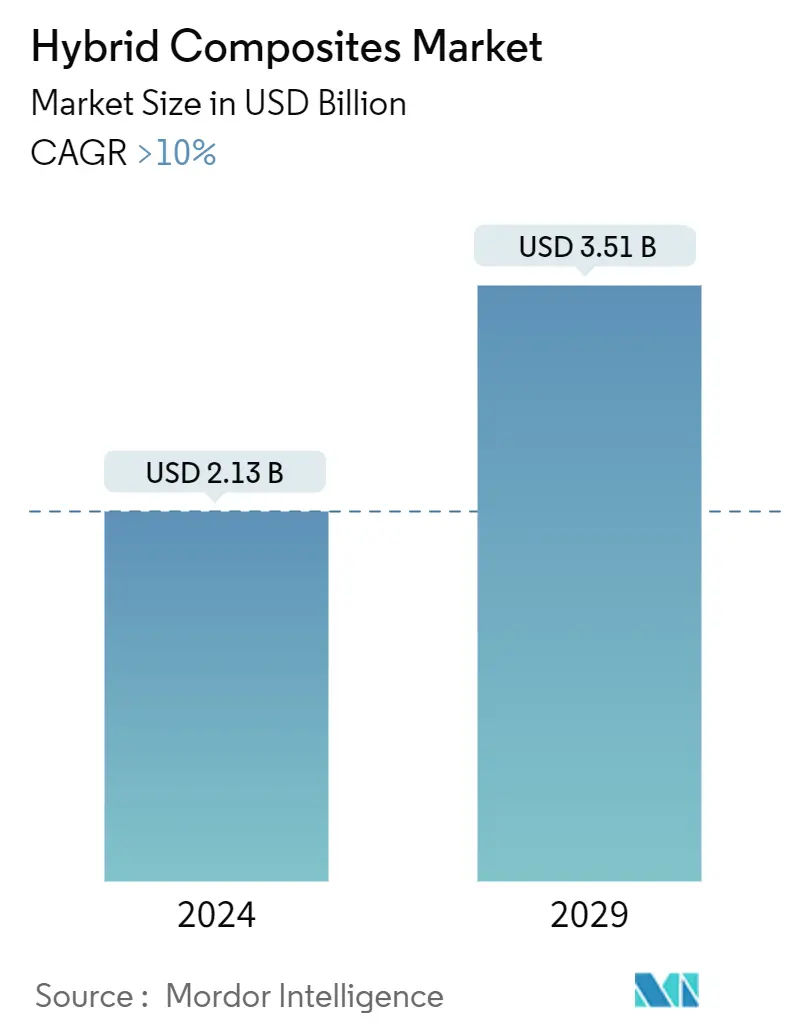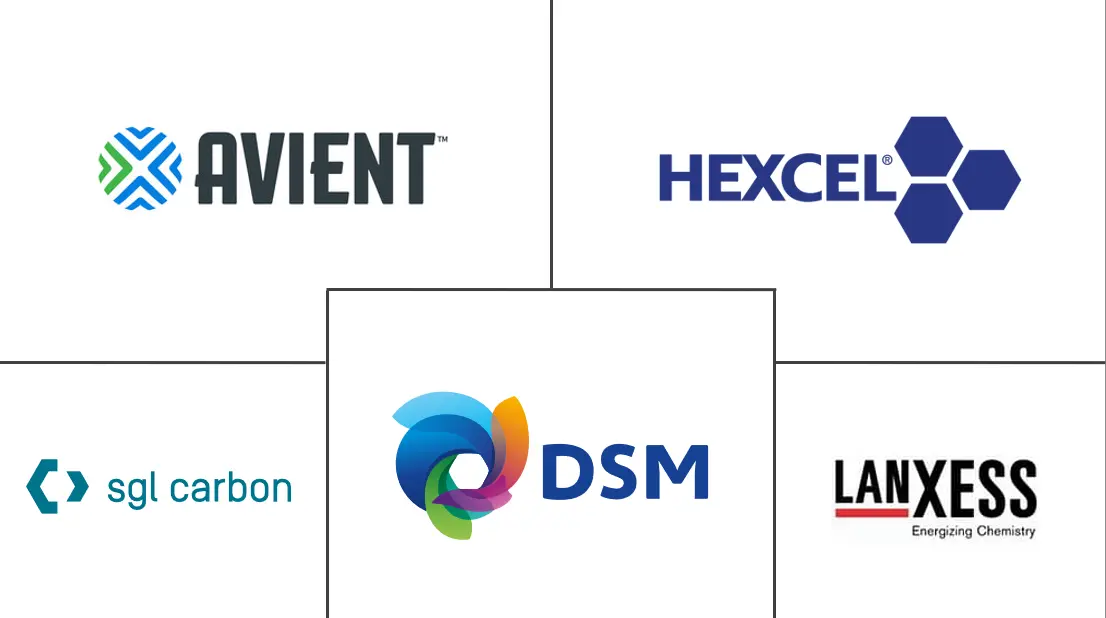Market Size of Hybrid Composites Industry

| Study Period | 2019-2029 |
| Market Size (2024) | USD 2.13 Billion |
| Market Size (2029) | USD 3.51 Billion |
| CAGR (2024 - 2029) | 10.00 % |
| Fastest Growing Market | Asia Pacific |
| Largest Market | North America |
Major Players
*Disclaimer: Major Players sorted in no particular order |
Hybrid Composites Market Analysis
The Hybrid Composites Market size is estimated at USD 2.13 billion in 2024, and is expected to reach USD 3.51 billion by 2029, growing at a CAGR of greater than 10% during the forecast period (2024-2029).
The impact of the COVID-19 pandemic on the hybrid composites market was mixed. While it presented immediate challenges, it also highlighted the potential of these materials and triggered trends that could contribute to long-term growth.
Lockdowns and travel restrictions disrupted the flow of raw materials and finished products, leading to production delays and material shortages. Industries heavily reliant on hybrid composites, such as aerospace, automotive, and wind energy, experienced significant downturns due to travel restrictions and economic slowdown, dampening demand for material. On the flip side, the pandemic highlighted the need for advanced materials in medical devices and equipment, creating opportunities for biocompatible hybrid composites in prosthetics, implants, and surgical instruments.
- The growing adoption of composite materials in the light vehicle sector and compared to traditional composites, better properties exhibited by hybrid composites in comparison to the traditional composites is a major driving factor for the market studied.
- On the flip side, the processing and manufacturing of hybrid composites often involve complex and labor-intensive techniques, driving up costs and may act as a hindrance to the growth of the market studied.
- Exploring automation, digitalization, and additive manufacturing techniques for composite production can streamline processes, reduce costs, and improve product consistency can provide lucrative opportunities in the global market.
- Asia-Pacific is expected to witness the highest growth rate during the forecast period owing to the high demand from China.
Hybrid Composites Industry Segmentation
Hybrid composites are materials composed of a combination of two or more different types of reinforcing fibers or phases within a single matrix. These reinforcing elements can be various types of fibers, such as carbon, glass, aramid, or natural fibers, combined strategically to enhance the overall performance and properties of the composite material. The matrix, often a polymer resin, binds the reinforcing fibers together, providing structural integrity and support.
The hybrid composites market is segmented by fiber type, resin type, end-user industry, and geography. By fiber type, the market is segmented into carbon/glass, carbon/aramid, HMPP/carbon, wood/plastic, and other fiber types (natural fibers, basalt fibers, etc.). By resin type, the market is segmented into thermoset resins, thermoplastic resins, and other resins (PEEK(polyether ether ketone), etc.). By end-user industry, the market is segmented into automotive and transportation, construction and infrastructure, aerospace and defense, marine, and other end-user industries (sporting goods, medical, etc.). The report also covers the market size and forecasts for the hybrid composites market for 27 major countries across the major region.
For each segment, the market sizing and forecasts have been done on the basis of value (USD).
| Fiber Type | |
| Carbon/Glass | |
| Carbon/Aramid | |
| HMPP/Carbon | |
| Wood/Plastic | |
| Other Fiber Types (Natural Fibers, Basalt Fibers, etc.) |
| Resin Type | |
| Thermoset Resins | |
| Thermoplastic Resins | |
| Other Resin Types (PEEK(Polyether Ether Ketone), etc.) |
| End-user Industry | |
| Automotive and Transportation | |
| Construction and Infrastructure | |
| Aerospace and Defense | |
| Marine | |
| Other End-user Industries (Sporting Goods, Medical, etc.) |
| Geography | |||||||||||
| |||||||||||
| |||||||||||
| |||||||||||
| |||||||||||
|
Hybrid Composites Market Size Summary
The hybrid composites market is poised for significant growth, driven by the increasing adoption of these materials across various industries such as automotive, aerospace, and construction. Hybrid composites, particularly those reinforced with glass and carbon fibers, offer superior properties compared to traditional materials, making them an attractive choice for applications requiring high strength-to-weight ratios and corrosion resistance. The market's expansion is further supported by advancements in automation, digitalization, and additive manufacturing, which aim to streamline production processes and reduce costs. Despite challenges such as complex manufacturing techniques, the market is expected to benefit from the growing demand for lightweight and high-performance materials, especially in the Asia-Pacific region, where infrastructure and automotive sectors are experiencing robust growth.
The COVID-19 pandemic had a mixed impact on the hybrid composites market, causing initial disruptions but also highlighting the potential of these materials in new applications, such as medical devices. The Asia-Pacific region is anticipated to lead market growth, fueled by high demand from countries like China and India, where significant investments in construction and automotive industries are underway. The region's expanding economy and urbanization trends are expected to drive the demand for hybrid composites, particularly in building and construction applications. Key players in the market, including LANXESS, DSM, and Hexcel Corporation, are actively involved in developing innovative solutions to meet the increasing demand for sustainable and high-performance materials.
Hybrid Composites Market Size - Table of Contents
-
1. MARKET DYNAMICS
-
1.1 Drivers
-
1.1.1 Increasing Use of Composite Material in Light Vehicle Segment
-
1.1.2 Specific Hybrids offer Multi-threat Protection
-
1.1.3 Other Drivers
-
-
1.2 Restraints
-
1.2.1 High Processing and Manufacturing Costs
-
1.2.2 Concerns about Sustainability and Environmental Impact
-
-
1.3 Industry Value Chain Analysis
-
1.4 Porter's Five Forces Analysis
-
1.4.1 Bargaining Power of Suppliers
-
1.4.2 Bargaining Power of Buyers
-
1.4.3 Threat of New Entrants
-
1.4.4 Threat of Substitute Products and Services
-
1.4.5 Degree of Competition
-
-
-
2. MARKET SEGMENTATION (Market Size In Value)
-
2.1 Fiber Type
-
2.1.1 Carbon/Glass
-
2.1.2 Carbon/Aramid
-
2.1.3 HMPP/Carbon
-
2.1.4 Wood/Plastic
-
2.1.5 Other Fiber Types (Natural Fibers, Basalt Fibers, etc.)
-
-
2.2 Resin Type
-
2.2.1 Thermoset Resins
-
2.2.2 Thermoplastic Resins
-
2.2.3 Other Resin Types (PEEK(Polyether Ether Ketone), etc.)
-
-
2.3 End-user Industry
-
2.3.1 Automotive and Transportation
-
2.3.2 Construction and Infrastructure
-
2.3.3 Aerospace and Defense
-
2.3.4 Marine
-
2.3.5 Other End-user Industries (Sporting Goods, Medical, etc.)
-
-
2.4 Geography
-
2.4.1 Asia-Pacific
-
2.4.1.1 China
-
2.4.1.2 India
-
2.4.1.3 Japan
-
2.4.1.4 South Korea
-
2.4.1.5 Malaysia
-
2.4.1.6 Thailand
-
2.4.1.7 Indonesia
-
2.4.1.8 Vietnam
-
2.4.1.9 Rest of Asia-Pacific
-
-
2.4.2 North America
-
2.4.2.1 United States
-
2.4.2.2 Canada
-
2.4.2.3 Mexico
-
-
2.4.3 Europe
-
2.4.3.1 Germany
-
2.4.3.2 United Kingdom
-
2.4.3.3 France
-
2.4.3.4 Italy
-
2.4.3.5 Spain
-
2.4.3.6 NORDIC
-
2.4.3.7 Turkey
-
2.4.3.8 Russia
-
2.4.3.9 Rest of Europe
-
-
2.4.4 South America
-
2.4.4.1 Brazil
-
2.4.4.2 Argentina
-
2.4.4.3 Colombia
-
2.4.4.4 Rest of South America
-
-
2.4.5 Middle-East & Africa
-
2.4.5.1 Saudi Arabia
-
2.4.5.2 South Africa
-
2.4.5.3 Nigeria
-
2.4.5.4 Qatar
-
2.4.5.5 Egypt
-
2.4.5.6 UAE
-
2.4.5.7 Rest of Middle-East & Africa
-
-
-
Hybrid Composites Market Size FAQs
How big is the Hybrid Composites Market?
The Hybrid Composites Market size is expected to reach USD 2.13 billion in 2024 and grow at a CAGR of greater than 10% to reach USD 3.51 billion by 2029.
What is the current Hybrid Composites Market size?
In 2024, the Hybrid Composites Market size is expected to reach USD 2.13 billion.

